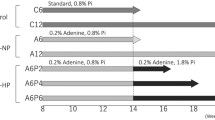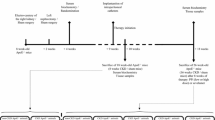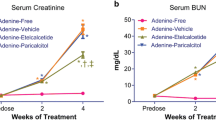Abstract.
Renal cortical nephrocalcinosis (C-NC) is a rare disorder of uncertain etiology. Using highly inbred (syngeneic) male Lewis rats, we describe the spontaneous occurrence of histologically detectable C-NC in sham operated control rats (Sham; n=12), its aggravation following grafting of the ascending thoracic aorta from a donor rat to the infrarenal aorta of a recipient (ATx; n=12), and differences in C-NC inhibition after 12 weeks of oral administration of magnesium (Mg), citrate and alkali. C-NC is characterized by Kossa-positive areas located in cells of the proximal tubule close to blood vessels and also, to a lesser extent, within glomeruli. After ATx there was vascular overproduction of endothelin (ET-1) but decreased production of nitrate; in renal cortical tissue there was an excess of calcium over Mg and phosphorus and oxalate over citrate. In plasma there was an increase in calcium and creatinine within the normal range. Calcification of tubular cells was eliminated by a preparation containing potassium, sodium and bases (from citrate degradation and bicarbonate) in addition to Mg. Less effective than the latter was Mg-potassium citrate and least effective, Mg citrate. The former treatment also normalized calcemia and urinary nitrate, but only incompletely suppressed ET-1 and had no significant effect on glomerular calcification or tissue and urinary oxalate. Urinary ET-1 excess appeared directly related to the cortical tissue calcium/Mg ratio, and urinary excretion of Mg, citrate and total protein appeared to be inversely related to the severity of C-NC. It was concluded that (1) the highly inbred rat is prone to precipitation of calcium phosphate in the renal cortex; (2) this type of C-NC occurs in close proximity to and within renal vascular tissue and is associated with an imbalance of vasoconstrictors and vasodilators of endothelial origin; (3) effective inhibition of C-NC can be achieved by an alkalinizing combination of Mg, potassium, sodium and citrate, underscoring its utility in the prophylaxis of pathological calcium phosphate deposition. The significance of these findings for the etiology and treatment of clinical disorders with renal and vascular calcification is uncertain and requires further investigation.
Similar content being viewed by others
Author information
Authors and Affiliations
Additional information
Electronic Publication
Rights and permissions
About this article
Cite this article
Schmiedl, A., Schwille, P.O., Bonucci, E. et al. Renal cortical calcification in syngeneic intact rats and those receiving an infrarenal thoracic aortic graft: possible etiological roles of endothelin, nitrate and minerals, and different preventive effects of long-term oral treatment with magnesium, citrate and alkali-containing preparations. Urol Res 29, 229–237 (2001). https://doi.org/10.1007/s002400100191
Received:
Accepted:
Published:
Issue Date:
DOI: https://doi.org/10.1007/s002400100191




